Module 2—Motion in Two Dimensions
 Read
Read
Read “Determining Components” on pages 83 and 84 of your textbook to see in greater detail another explanation of this skill you saw in the Component Vector Addition simulation.
 Self-Check
Self-Check
SC 2. Complete practice problem 2 for “Example 2.4” on page 84 of the textbook.
 Self-Check Answer
Self-Check Answer
SC 2.
Given
![]() = 10 m/s [245°]
= 10 m/s [245°]
Required
the x component (vx)
the y component (vy)
Analysis and Solution
The angle (θ) between the x-axis and the velocity vector is (245° – 180º) = 65°.
The x component and the y component will both be negative.
cos θ = ![]()
Rx = R cos θ
vx = – (10 m/s)(cos 65°)
= 4.2 m/s
sin θ = ![]()
Ry = R sin θ
vx = – (10 m/s)(sin 65°)
= – 9.1 m/s
Paraphrase
The x component of the cyclist’s velocity is –4.2 m/s, and the y component of the cyclist’s velocity is –9.1 m/s.
 Read
Read
Read “Adding Vectors Using Components” on pages 85 through 89 of your textbook to see an explanation of this skill you saw in the Component Vector Addition simulation.
 Lesson 2 Lab: Adding Vectors Graphically
Lesson 2 Lab: Adding Vectors Graphically
In the previous lesson you added two vectors graphically to find the ground speed in an airplane flight. Any slight variation in measuring lines or angles could give an erroneous answer. Now it is time to calculate the answer mathematically to see how close you were using a guided simulation. You will need a calculator, a pencil, an eraser, and a separate sheet of lined paper. Open the Numerical Vector Addition simulation, and follow the instructions.
Look in your Physics 20 course folder to see your previous work on the air and ground speed problem. How close to the calculated answer was your graphical solution? What are the unique advantages you see to each method?
Now you have a chance to do a vector addition question on your own with the following Self-Check question.
 Self-Check
Self-Check
SC 3. Complete practice problem 2 for “Example 2.5” on page 88 of the textbook.
 Self-Check Answer
Self-Check Answer
SC 3.
Given
![]() = 15 m [15° N of E]
= 15 m [15° N of E]
![]() = 13 m [5° W of N]
= 13 m [5° W of N]
Required
the displacement of the soccer player (![]() )
)
Analysis and Solution
Let the x-axis represent the east direction and the y direction be the north direction. Determine the x and y components of each vector, and add the x and y components separately. Then find the magnitude of the resultant using the theorem of Pythagoras. Finally, find the angle of the resultant using the tangent function.
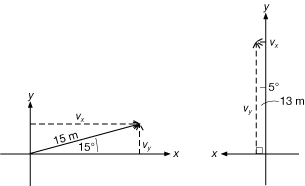
In the second diagram, the angle between the x-axis and the vector is (90° – 5°) = 85°.
x direction |
y direction |
|
| d1 |
|
|
| d2 |
|
|
| Sum | dx = 13.36 m | dy = 16.83 m |
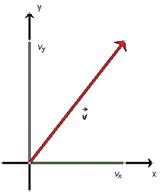
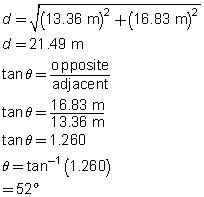
Paraphrase
The displacement of the soccer player is 21 m [52° N of E].
Lab Summary
How do you determine and illustrate the sum of two vectors?
The sum of two vectors is determined using the following steps:
-
Determine the components of each vector using the appropriate trigonometric functions.
-
Add the respective components to determine the total x and total y vectors.
-
Construct a right triangle using the total x and y vectors.
-
Determine the magnitude of the sum (hypotenuse) using the Pythagorean theorem.
-
Determine the direction of the sum using the appropriate trigonometric function.
 Self-Check
Self-Check
SC 4. Using the component method, calculate the resultant (sum) of the following two vectors.
![]() = 185 m/s, 45° polar (positive)
= 185 m/s, 45° polar (positive)
![]() = 95 m/s, 320° polar (positive)
= 95 m/s, 320° polar (positive)
Show all required calculations and diagrams, and identify the direction using the polar (positive) specification. You may use the Vector Addition: Numerical simulation to add the vectors in order to verify the resultant magnitude and direction.
-
Make a vector diagram for
 , and calculate the components.
, and calculate the components.
-
Make a vector diagram for
 , and calculate the components.
, and calculate the components.
-
Add the components of the resultant vector.
-
Draw the resultant vector.
-
Calculate the resultant magnitude using the Pythagorean theorem.
-
Calculate the resultant direction using the tangent function. Express the direction in terms of the polar (positive) specification.
 Self-Check Answers
Self-Check Answers
SC 4.
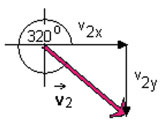
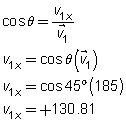
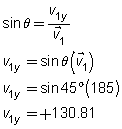

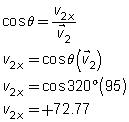
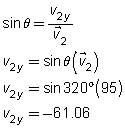
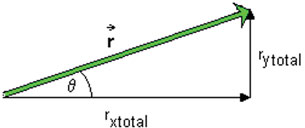
c. rxtotal = v1x + v2x = (+130.81) + (+72.77) = +203.5
d. rytotal = v1y + v2y = (+130.81) + (-61.06) = +69.75
e. 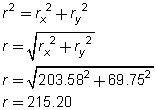
The magnitude of the resultant vector is 215 m/s.
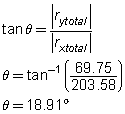
f. The direction of the resultant is 18.9°.
 Module 2: Lesson 2 Assignment
Module 2: Lesson 2 Assignment
Remember to submit the answers to TR 1 and TR 2 to your teacher as part of your Module 2: Lesson 2 Assignment.
 Try This
Try This
TR 1. Using the component method, calculate the resultant (sum) of the following two vectors.
 = 175 m/s, 70° polar (positive)
= 175 m/s, 70° polar (positive)-
 = 200 m/s, 200° polar (positive)
= 200 m/s, 200° polar (positive)
Show all required calculations and diagrams, and identify the direction using the polar (positive) specification. You may use the Vector Addition: Numerical simulation to add the vectors in order to verify the resultant magnitude and direction.
- Make a vector diagram for
 , and calculate the components.
, and calculate the components.
- Make a vector diagram for
 , and calculate the components.
, and calculate the components.
- Add the components of the resultant vector.
- Draw the resultant vector using the components.
- Calculate the resultant magnitude using the Pythagorean theorem.
- Calculate the resultant direction using the tangent function. Express the direction in terms of the polar (positive) specification.
TR 2. Using the component method, calculate the resultant (sum) of the following two vectors.
 = (+135 m/s, –120 m/s) components
= (+135 m/s, –120 m/s) components = (–200 m/s, –45 m/s) components
= (–200 m/s, –45 m/s) components
Show all required calculations and diagrams, and identify the direction using the polar (positive) specification. You may use the Vector Addition: Numerical simulation to add the vectors in order to verify the resultant magnitude and direction.
- Add the components of the resultant vector.
- Draw the resultant vector.
- Calculate the resultant magnitude using the Pythagorean theorem.
- Calculate the resultant direction using the tangent function. Express the direction in terms of the polar (positive) specification.